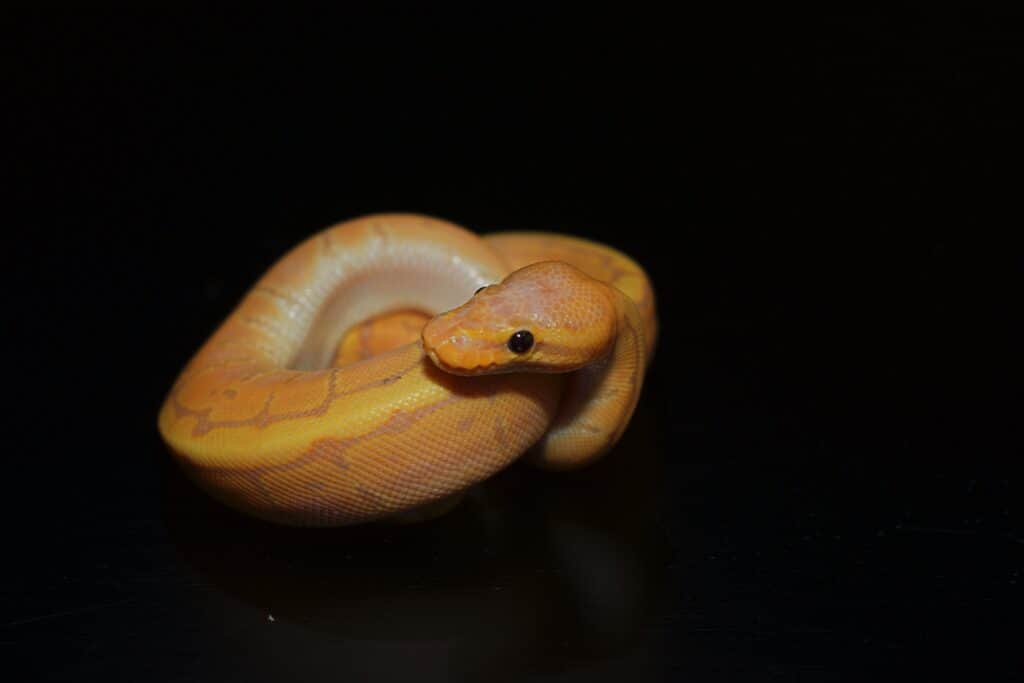Fire Ball Python
Python regius
The fire ball python morph is known for its rich golden and reddish-brown coloration.
Advertisement
Fire Ball Python Scientific Classification
- Kingdom
- Animalia
- Phylum
- Chordata
- Class
- Reptilia
- Order
- Squamata
- Family
- Pythonidae
- Genus
- Python
- Scientific Name
- Python regius
Read our Complete Guide to Classification of Animals.
Fire Ball Python Conservation Status
Fire Ball Python Facts
- Prey
- Small rodents, birds, fish, amphibians
- Main Prey
- Rodents
- Group Behavior
- Solitary
- Fun Fact
- The fire ball python morph is known for its rich golden and reddish-brown coloration.
- Other Name(s)
- Royal python
View all of the Fire Ball Python images!
“The fire ball python morph stands out thanks to its light golden to reddish-brown patterning.”
Fire Ball Python Summary
Since the early 1990s, thousands of unique ball python morphs have been developed through selective captive breeding. Most of these morphs, such as the fire variety, are color morphs. This simply means experts breed them to display a particular coloration, patterning, or both.
Fire ball pythons have an overall more vibrant and golden or reddish coloration than standard, wild-type ball pythons. Their patterning is largely the same as that of the wild-type ball python, but its black markings are a lighter, reddish-brown in color, while the yellows are more rich, vibrant, and golden in appearance than usual.
The incomplete dominant trait for the fire morph was first documented in 1995 by New England Reptile Distributors (NERD). Over the following years, it was refined and developed into the morph we know today, with it first hitting the market in the early 2000s.
Because it is a base morph, breeders are able to easily combine it with other traits to create new morphs. Variations of the fire morph include the firefly, fire pied, and disco inferno morphs.
3 Amazing Fire Ball Python Facts
- Baby fire ball pythons are very similar in color to standard, wild-type ball pythons. However, as they age, their golden-brown coloration becomes more apparent each time they shed!
- They were among the first base morphs to reliably reproduce in captivity.
- Fire ball pythons are fairly inexpensive, ranging from around $150 to $300 per snake. However, more complicated variations of the morph, such as the fire puzzle, fire pied, and super fire ball pythons can cost over $500 and sometimes well into the thousands!
Where Do Fire Ball Pythons Live
The standard ball python, Python regius, is native to Sub-Saharan Africa. Large populations exist in countries like Nigeria, Ghana, and Cameroon. Ball pythons mainly reside in grassland and savanna habitats, but they can also thrive in more densely forested regions.
As a base morph, the fire ball python can technically occur naturally in the wild, though it is very rare and poorly documented outside of captive breeding. It is the result of an incomplete dominant trait. Essentially, this means only one copy of the gene must be present for the morph to physically manifest. New England Reptile Distributors, NERD, first officially recorded the fire morph in 1995 as a genetic mutation.
Since the early 2000s, many variants of the fire morph have developed, most notably the super fire morph, which contains two copies of the fire gene. This results in an eerily black-eyed, mostly white snake with vibrant yet reduced golden-yellow patterning.
Today, the fire morph is one of the more common and accessible varieties sold, with many large-scale reptile breeders producing their own lines of fire ball pythons.
Base morph fire ball pythons typically cost around $150 to $300, but more complex morphs with multiple traits such as the fire pied or firefly tend to be much more expensive. Prices can vary from breeder to breeder, depending on the morph’s overall availability on the market and its current demand.
Fire Ball Python Scientific Name
Their scientific name is Python regius, which loosely translates to “royal python.” This is a reference to the legends that Queen Cleopatra and other Egyptian royals wore small pythons around their wrists.
Because all ball python morphs belong to the same species, they share the same scientific name.
Fire Ball Python Population & Conservation Status
According to the IUCN Red List, the ball python, Python regius, has been classified as near threatened since 2012.
The ball python’s populations within its native range are decreasing in the wild, though they are not severely fragmented or in imminent danger of extinction at this time. However, the species could see future endangerment due to deforestation and habitat loss. It is unknown exactly how many individuals currently exist in captivity and/or in the wild.
Appearance and Description
The fire ball python is a color morph, meaning the trait primarily affects the snake’s coloration and patterning. It has reddish-brown and golden tones, in contrast to the darker, more cool browns and yellows of standard, wild-type ball pythons. This results in the snake having a warmer, more fiery coloration overall, though the difference is fairly subtle.
Additionally, the patterning around the snake’s head tends to be especially vibrant, with a pale, faded yellow or whitish spot in the center. The scales around the lips and nostrils range from bright yellow to pale white.
It is important to note that baby fire ball pythons closely resemble wild-types. The fire trait becomes bolder as the snake ages, with its coloration becoming warmer and redder with each successive shed. Upon reaching adulthood, fire ball pythons are clearly and easily differentiated from wild-types and other morphs.
How to identify a fire ball python:
- Golden and reddish tones overall
- Light and vibrant head coloration
- Overall coloration becomes warmer with age; adults are much easier to identify than hatchlings and juveniles

The fire trait becomes bolder as the snake ages, with its coloration growing warmer with each successive shed.
©Keung/Shutterstock.com
Fire Ball Pythons: Are They Dangerous?
Like all members of the Python family, the ball python is not venomous, nor is it dangerous to humans. It is an ambush hunter that kills its prey via constriction with its strong, flexible muscles. Fortunately, it is small (around 3 to 6 feet long) and non-aggressive towards humans, much preferring to hunt small rodents and birds. The species’ common name is a reference to the snake’s tendency to defensively curl up in a ball when startled or threatened by larger animals.
In addition to being small and quite docile, the ball python lacks fangs and has small teeth with weak jaws. This means its bite is not particularly painful or capable of seriously harming much more than the occasional unlucky rat.
However, when stressed or cornered, a ball python may strike or bite defensively. If a ball python bites you, gently place the snake back in its enclosure and make sure it is not hurt. Next, clean the wound with warm water and soap. Bandage the bite wound to ward off infection. Generally, ball python bites are minor and do not require much medical intervention.
Fire Ball Python Behavior and Humans
The ball python has quickly become one of the most popular pet snakes on Earth. This is largely thanks to its hardy, docile nature, small size, unique appearance, and overall simple care requirements. They are also relatively easy to breed in captivity, which has resulted in thousands of unique morphs.
Ball pythons initially became popular in the exotic pet trade in the early 1990s. The fire morph was first documented and reliably reproduced in 1995 by New England Reptile Distributors. It was among the first ball python morphs to be reproduced and sold on a large scale.
Today, the fire morph is one of the most popular, inexpensive, and easily accessible ball python varieties on the market. It has also combined with dozens of other morphs to create new varieties, such as the unique firefly and fire pied morphs.
As a base morph, it is possible for fire ball pythons to occur in the wild naturally, though this is extremely rare and poorly documented.
Related Animals
View all 91 animals that start with FThank you for reading! Have some feedback for us? Contact the AZ Animals editorial team.

















